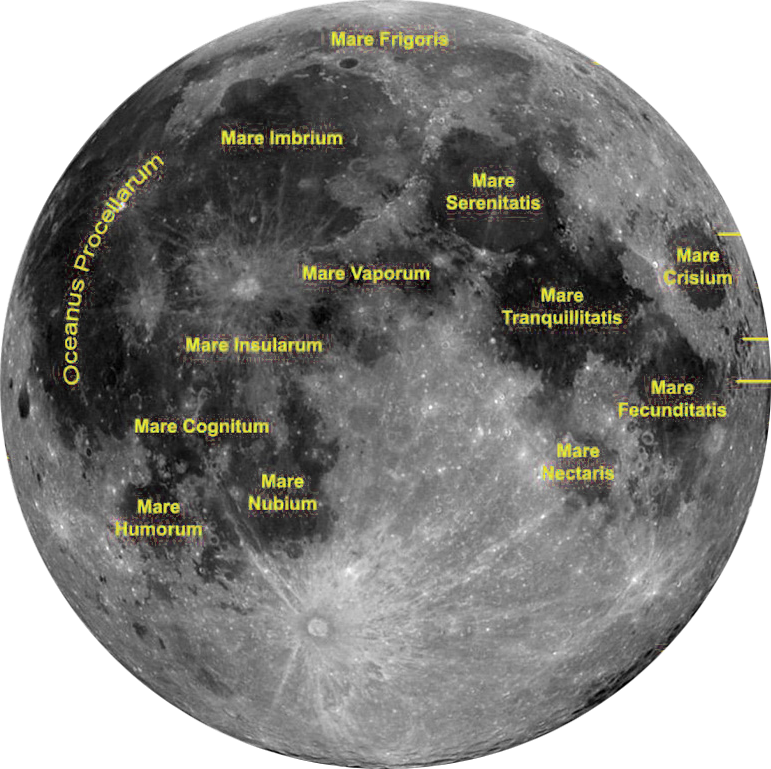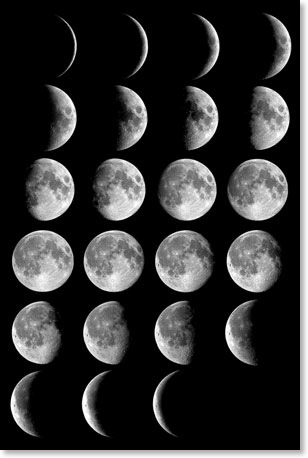

Of all the celestial sights that pass across the sky, none is more inspiring or universally appealing than our planet’s lone natural satellite, the Moon. Remember the rush of excitement that you felt when you first peered at the rugged lunar surface through a telescope or binoculars? (If you haven’t, you’ll be amazed.) The first view of its broad plains, coarse mountain ranges, deep valleys, and countless craters is a memory cherished by stargazers everywhere.
A New View Every Night
Since the Moon orbits our planet in the same time that it takes to rotate once on its own axis, one side of the Moon perpetually faces Earth. Though the face may be the same, its appearance changes dramatically during its 27.3-day orbital period, as sunlight strikes it from different angles as seen from our standpoint. Due to the sunlight’s changing angle, the Moon presents a slightly different perspective every night as it passes from phase to phase. No other object in the sky holds that distinction. (Note that it is actually 29.5 days from New Moon to New Moon; the added time is due to Earth’s motion around the Sun.)
The Moon is the ideal target for all amateur astronomers. It is bright and large enough to show amazing surface detail, regardless of the type or size of telescopic equipment, and can be viewed just as successfully from the center of a city as from the rural countryside. But bear in mind that some phases are more conducive to Moon-watching than others.
The Best Times to View It
Perhaps the most widespread belief is that the Full Moon phase is the best for viewing, but nothing could be further from the truth. Since the Sun is shining directly on the Earth-facing side of the Moon at this phase, there are no shadows to give the lunar surface texture and relief. In addition, the Full Moon is so bright that it can overwhelm the observer’s eye. Although no permanent eye damage will result, the Full Moon is uncomfortable to look at even with the naked eye. Instead, the best time to view the waxing Moon is a few nights after New Moon (when the Moon is a thin crescent), up until two or three nights after First Quarter (First Quarter is when half of the visible disk is illuminated). The waning Moon puts on its best show from just before Last Quarter to the New Moon phase. These phases show finer detail because of the Sun’s lower elevation in the lunar sky.
Using a Moon Filter Improves the View
No matter what the phase of the Moon is, the view is almost always better through a lunar filter. It screws into the barrel of a telescope eyepiece and cuts the bright glare, making for more comfortable observing and bringing out more surface detail. Some lunar filters, called variable polarizing filters, act something like a dimmer switch, permitting adjustment of the brightness to your liking.
Notable Surface Features
The Moon is dominated by large, flat plains known as maria; the singular is mare (meaning "sea"), which is pronounced (MAH-ray). Maria were first thought to be large bodies of water. In reality, the maria are ancient basins flooded by long-solidified lava created some three billion years ago when the Moon was still volcanically active. All are relatively free of craters except for a few scars from impacts that have occurred since. Their romantic-sounding names, such as the Sea of Crises, Sea of Fertility, Sea of Serenity, Ocean of Storms, and the Sea of Tranquility, are believed to date back to the mid-17th century.
Surrounding the maria are the lunar highlands, dominated by nearly uncountable craters that measure up to several hundred miles across. Most are believed to have been created when debris from the formation of the solar system collided with the young Moon, leaving a permanent record of the barrage on its surface. Some of the more spectacular lunar craters include Tycho, Copernicus, Kepler, Clavius, Plato, and Archimedes, all named for figures of historical stature. Tycho, Copernicus, and Kepler are especially noteworthy, as each displays a broad pattern of bright rays radiating outward. These are particularly impressive during the Moon’s gibbous phases (between Quarter and Full), when the Sun appears high in the lunar sky. The Moon also has several noteworthy mountain ranges, such as the Alps and Apennines, as well as straight cliffs, towering ridges, broad valleys, and small, sinuous rilles.
Focus on the Terminator Region
The greatest amount of detail is visible along the Moon’s terminator, the line separating the lighted area of the lunar disk from the darkened portion. It is here that the Sun’s light strikes the Moon as the narrowest angle. This casts the longest shadows, increasing contrast of lunar features and showing the greatest three-dimensional relief. Sometimes you will notice a bright "island" surrounded by darkness on the dark side of the terminator. That’s a high peak, tall enough to still catch the light of the setting Sun, while the lower terrain around it does not.
A Great Target for Telescopes or Binoculars!
So, the next time the Moon is riding high in the sky, take time to visit our nearest neighbor in space. A binocular provides a terrific view; use a tripod or brace it against something to hold it steady. If you have a telescope, begin with a low-power eyepiece. Slowly scan across the lunar disk and try to imagine the emotion that the astronauts must have felt as they orbited that alien world, a world so close to our own, yet so astonishingly hostile and different — "magnificent desolation," as Edwin Aldrin put it during his and Neil Armstrong’s historic visit on Apollo 11 in 1969. Then, switch to higher powers for close-up studies of specific areas and features. Get a lunar map or lunar atlas to identify specific craters and features.
Checklist of Observable Features
1) Maria — Once thought to be oceans of water, these "seas" are actually vast plains of hardened lava. In some of them you will see giant ripples.
2) Craters — Like snowflakes, no two appear exactly alike. In the center of some larger craters, look for peaks formed from the upsurging of molten rock at the impact point. Look for small craterlets inside craters, too.
3) Crater Rays — Long, bright "splash marks" radiating from a few craters, such as Copernicus and Tycho. Best observed at Full or Gibbous phases.
4) Mountains — Several major mountain ranges scar the lunar surface. Check out the largest one, the Apennines, in the southern half of the Moon’s disk along the vertical centerline. You can’t miss it!
5) Domes — These small, low mounds often have a tiny craterlet in the middle and tend to cluster in groups.
6) Rilles — Filamentous faults and channels, some of which were once meandering rivers of flowing lava.
The question of which telescope is best for the beginner is asked a lot. Here are our thoughts on the best beginner telescope — it really depends on what is important to you! www.Telescope.com
The Moon was created on the 4th day of creation and is referred to in Genesis 1:16 as the lesser light. “And God made two great lights; the greater light to rule the day, and the lesser light to rule the night: he made the stars also.”

Phases of the Moon
The Moon always looks impressive when viewed through a telescope. Even a small telescope brings out beautiful detail on the Moon's surface. The reason for this is simple - the Moon is close to us. “Close” in this case is a relative term, of course, because the Moon is actually about 250,000 miles away from the Earth!
The relative nearness of the Moon makes it a great target for anybody with a telescope or a pair of binoculars. In fact, you can identify about a dozen features of the moon with the naked eye. Of course, it's always more fun when you know what you're looking at. As a note of encouragement - learning about what you are looking at and even planning a few targets to look for when you start observing the Moon will make your viewing time infinitely more rewarding.

When you look at the Moon, you will see that the lunar surface is divided by the a line that separates the bright part of the Moon from the dark part of the Moon. This line is called the terminator.
Near the terminator, the moon's surface details are the most dramatic because the Sun's light is casting shadows on the lunar surface. As you look away from the terminator onto the Moon's bright side the surface appears smoother, because it is being illuminated by a higher Sun that casts few shadows.
The large grey parts of the moon that you can see with your naked eye are called maria (MAH-ree-a). This is the Latin plural of mare (MAH-ray), which means “sea.” In 1651 the Italian astronomer Giambattista Riccioli gave them fanciful names such as Mare Tranquillitatis (“Sea of Tranquillity”) and Oceanus Procellarum (“Ocean of Storms”) — of course, today we know that these are not seas or oceans, but the names have stuck.
Moon’s Maria
The major maria are the Moon's most important geographical features and you can easily learn them with a pair of binoculars or a small telescope. If you made it a point to memorize one or two of them each night, it will only be a matter of time before the Moon's geography becomes as familiar to you as the major continents on Earth.Moon Craters
The most famous and exciting parts of the lunar surface are the craters! Dr. Walt Brown's Hydroplate Theory examines new evidence shows that the earth has experienced a devastating, worldwide flood, whose waters violently burst forth from under earth’s crust. Standard “textbook” explanations for many of earth’s major features are scientifically flawed. We can now explain, using well-understood phenomena, how this cataclysmic event rapidly formed so many features. For more information, see Dr. Brown's website here.Visit (www.4thdayalliance.com) below.
Genesis 1:16 And God made two great lights; the greater light to rule the day, and the lesser light to rule the night: he made the stars also.
Psalm 136:7 To him that made great lights: for his mercy endureth for ever:
Psalm 136:8 The sun to rule by day: for his mercy endureth for ever:
Psalm 136:9 The moon and stars to rule by night: for his mercy endureth for ever.
Starlight And The Age Of The Universe
GoodNewsPost.com